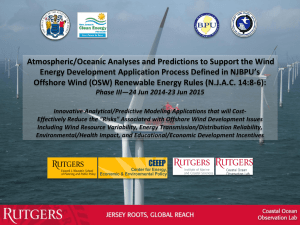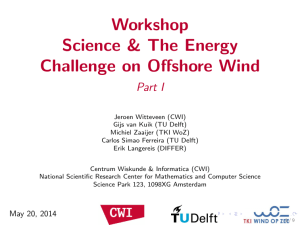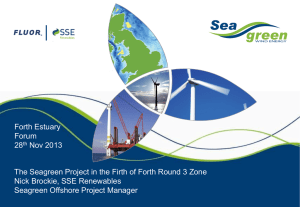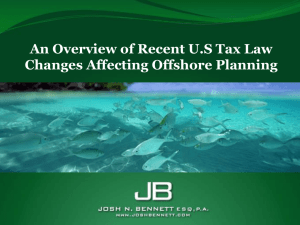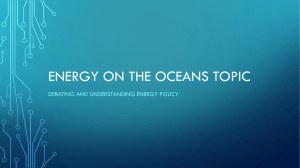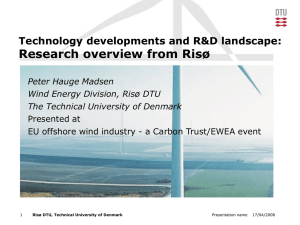TI - PCWG > Power Curve Working Group
advertisement
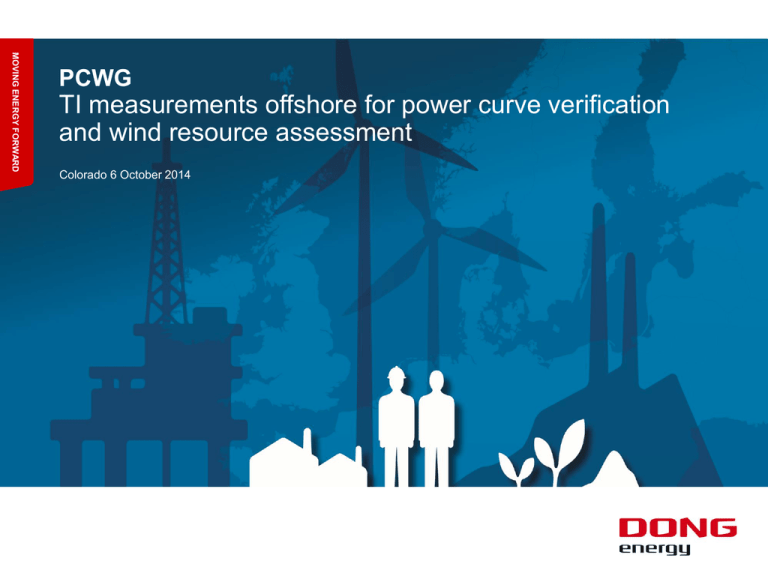
MOVING ENERGY FORWARD PCWG TI measurements offshore for power curve verification and wind resource assessment Colorado 6 October 2014 DONG Energy is one of the leading energy groups in Northern Europe Our business is based on procuring, producing, distributing and trading in energy and related products in Northern Europe. DONG Energy has 6,500 employees and is headquartered in Denmark. Exploration & Production Wind Power Thermal Power Customers & Markets 2 Wind Power Offshore projects in operation, under construction and development Principal activity Development, construction and operation of offshore wind farms Market position Market leader in offshore wind, has built 35% of European capacity Strong pipeline of projects in lead-up to 2020 Strategic targets for 2020 Installed offshore wind capacity (gross installed): 6.5 GW Reducing offshore wind Cost of Electricity to below EUR 100/MWh3 Outer Solway Walney Ext. Westermo st Rough Walney 1+2 Northern Ireland WoD S Barrow Lincs Burbo Bank Ext. Hornsea Heron Hornsea Njord Race bank Gunfleet Sands 1+ 2 Burbo Bank London Array 1 Fécamp In operation Courseulles-sur-Mer Under construction Under development Saint-Nazaire Horns Rev 2 Horns Rev 1 Tunø knob Vindeby Anhol t Middelgrund en Avedøre Holme Nysted Gode Wind 3+4 Gode Wind 1+2 Borkum Riffgrund 1 Borkum Riffgrund 2 Borkum Riffgrund West 1 Den Helder Breeveertien West Rijn TI measurements offshore for power curve verification Relevance of TI measurements in the inner/outer range concept Power curve verification offshore: two beam nacelle LIDAR TI based on two beam nacelle LIDAR Readiness from 3rd party independent testers in the use of nacelle LIDAR Characterization of ambient offshore turbulence intensity in Northern Europe 4 TI measurements in the inner/outer range concept Inner Range: the range of conditions for which one can expect to achieve an Annual Energy Production (AEP) of 100% (relative to a reference power curve). Outer Range: the range of conditions for which one can expect to achieve an AEP of less than 100%. Stated another way the outer range is the range of all possible conditions excluding those in the inner range. It is envisaged that suppliers may offer some level of reduced warranty for the outer range 5 TI measurements in the inner/outer range concept TI measurement as a good proxy for stability offshore TI for offshore site classification (second part) Focus on the inner range for power curve guarantees Being able to measure "type B" performance issues (inner to WTG) Eventual use other measurements to monitor atmospheric stability (ground based /floating LIDARs / sea surface temperature) Power curve test as a dialogue instrument for performance improvements with WTG supplier 6 Power curve verification offshore: two beam nacelle LIDAR Nacelle-based LIDAR IEC61400-12-1 Ed.1 Cost effective solution Very costly offshore ! 7 Power curve verification offshore: two beam nacelle LIDAR EUDP project lead by DTU: demonstration test at Avedøre 8 Power curve verification offshore: two beam nacelle LIDAR Comparison of results as outcome of the EUDP project lead by DTU DTU Wind Energy E-0016 9 Power curve verification offshore: two beam nacelle LIDAR Comparison of results as outcome of the EUDP project lead by DTU DTU Wind Energy E-0016 10 TI based on two beam nacelle LIDAR Comparison of results as outcome of the EUDP project lead by DTU 1) The lidar calibration uncertainty 2) The uncertainty due to the terrain orography 3) The uncertainty related to the measurement height (if this one goes out of the range hub height +/- 2.5%) 4) The uncertainty of the tilt inclinometers DTU Wind Energy E-0016 11 TI based on two beam nacelle LIDAR Formulation use for computing TI with a two beam nacelle LIDAR Arithmetic average of the TI of each beam : DTU Wind Energy E-0016 12 3rd party independent testers readiness Readiness1 is confirmed by: 5 different independent testers having participated in bids for testing services 3 different independent testers have been actively involved in the nacelle LIDAR power curve analysis Lack of IEC standard does not compromise quality Lack of IEC coverage may compromise acceptance from non technically well informed agents in our value change 1 EUDP program was published in January 2013 13 TI measurements offshore for power curve verification Relevance of TI measurements in the inner/outer range concept Power curve verification offshore: two beam nacelle LIDAR TI based on two beam nacelle LIDAR Readiness from 3rd party independent testers in the use of nacelle LIDAR Characterization of ambient offshore turbulence intensity in Northern Europe 14 Characterization of Ambient Offshore Turbulence Intensity from Analysis of Nine Offshore Meteorological Masts in Northern Europe Masters Thesis in collaboration with Nicolai Nygaard & Miriam Marchante Jiménez at DONG Energy and Rozenn Wagner and Ameya Sathe at DTU Risø Wind Energy. Daniel Pollak European Wind Energy Masters Program 2014 MSc Wind Energy Engineering –Tech. Univ. of Denmark 2014 MSc Engineering Wind Physics – Univ. of Oldenburg 2014 BSc Meteorology – Penn State 2011 NCAR/CU Intern Summers 2009-2012 14 Motivation & Goals Turbulence Intensity (TI) Why TI is Important to Understand The degree of fluctuations about the mean wind speed within wind field 𝑇𝐼 = 𝜎𝑈 𝑈 Fatigue loads on turbine structure dependent on TI knowledge of TI fosters optimal turbine design To properly model wakes (lower turbulence results in slower wake recovery and more wake losses) this work provides insight and could be used as input in future models Of value to both research and industry Data Availability 15 9 offshore met masts throughout Northern Europe Scale hitherto not examined Thesis Research Questions Turbulence Parameters Discussed σU – wind speed standard deviation TI – ambient turbulence intensity How do these turbulence parameters vary with wind speed (𝑼), height (z) and wind direction (θ) at the nine different sites? Are these relationships regional or strictly site dependent? How do the found trends compare with previous studies and the IEC 61400-3 standards for offshore wind turbine design? How do these relationships vary with fetch or proximity to coast? 16 The Data – 9 Met Masts • 1-5 years of data per mast between 20052013 (except M2) • A wealth of data with speed and direction data available at numerous heights • 9 masts with 74 sets of wind speed data (1-3 obs per height) • Ranging from 7-111km from nearest land • 10 minute data – analyzed in yearly periods to avoid intro of seasonal bias • Filtering criteria implemented; mast shadow corrected 17 σU vs Speed - Scatterplots *IEC 61400-3 states that σU increases linearly with height. *Not the case as slope changes around transition from thermal to wavedriven turbulence *Bin where change occurs is height 𝑚 dependent (8-14 ) 𝑠 *Note persistence of low σUw at ↑U *Lower heights see the influence of waves at lower wind speeds Thermal 18 Mechanical TI vs Speed - Scatterplots F1 Thermal Mechanical *IEC states that TI monotonically decreases, not the case offshore *Change in slope of σU corresponds to minimum in TI curve due to transition between turbulence generating sources. (Height dependent : 8-14 m/s) * More scatter with thermally driven turbulence: vast differences between TI observed in stable versus unstable conditions *Decreasing TI with increasing z; further from air-sea interface 19 • Very similar trends, especially at 50, 70 and 80m. Less agreement at 30m • Same closeness observed with σU • Nearly universal relationship universal in Northern Europe when averaging over all wind directions, especially at high U 20 Turbulence Intensity All Mast Comparison – TI vs Speed 50m Wind Speed (m/s) IEC 61400-3 Standard: Discrepancies Found Design Requirements for Offshore Wind Turbines (Based on Onshore IEC 61400-1 Standard) IEC 61400-3 Standard 21 Thesis Realizations * σU is unchanging with height * σU, σσU increase w/ height @ ↑U * σU increases linearly with height * σU experiences change in slope w/ increasing U (turb transition) * σσU invariant w/ height & U * σσU does vary some with U * TI monotonically decreases w/ increasing wind speed * TI unchanging with height * TI decreases until a heightdependent turbulence transition point after which TI increases * Δσ equals equation above & unchanging with height * Values for Δσ much larger and height-dependent • Standard is not sufficient for offshore applications. Wang (2013) suggested changes; This thesis could contribute to future analysis σU Vertical Profile Dependence on Speed • Nearly constant with height at low speeds: thermal mixing • Strong decrease w/ height at high speeds due to generation of turbulence at airsea interface • Slightly higher values at sites closer to land 22 Regional Similarities – Vertical Wind Profile • One of key differentiable features between masts is proximity to shore • Similarities in average wind speed and average TI seen between masts within similar geographic region • Four regions demarked for the directional dependency analysis Far Offshore Region East Coast UK West UK / Irish Sea West Coast DK – HO, F1, F3 – HU, LA – SF1, SF2 – F3, M2, M8 23 Utilized Google Earth Measurement Tools TI Not Necessarily Monotonic with Fetch TI @ Height Closest to 50m • TI decreases with increasing fetch up until 40-50 km from coast due to lower roughness offshore • Thereafter, TI increases slightly with increasing fetch fully developed waves and larger swell 24 • At all sites with swaths of fetch >100-200 km, the largest TI values were observed in these sectors. For sites when the nearest land < 40 km, additional factors contribute to max TI sectors. TI vs θ – Far Offshore Region (F1, F3, HO) F1 • Far Offshore is >40 km from coast • TI larger in sectors with fetch >200 km and lowest in land sectors • Also observed in other regions 25 Conclusions • σU, TI examined for dependencies on U, z, θ • Average TI at 50m ranged from 6.3 to 7.4% • σU increases with speed as expected, but not linearly as in IEC and after the turbulence transition, TI begins to increase with increasing wind speed, also contrary to the IEC standard • σU ,TI vs. U – strong similarity in trends indicating a nearly universal relationship across Northern Europe, especially at higher heights • Fetch found to be vital proxy for directional dependence on TI. TI decreases with increasing fetch until ~50km where it increased • TI predominantly is maximized in sectors with fetch >100-200 km (well-developed waves and swell) • At sites closer to shore, factors such as mountains and coastal orientation also lead to max TI sectors. 26
